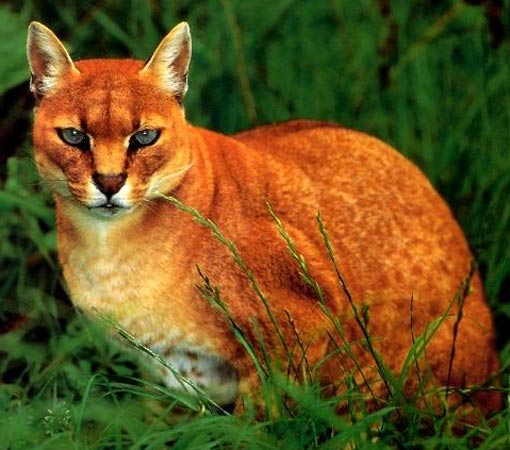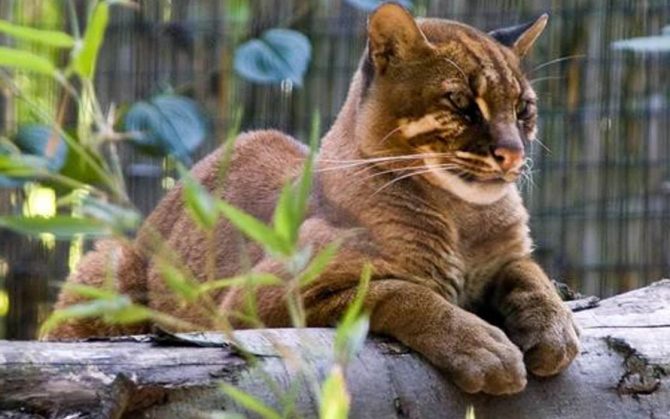Types Of Wild Cats: All Cats In The Cat Family Part 1
11/ 28/2023 by Active Wild Admin
activewild.com
Felidae: The Cat Family
There are 41 cat species in the cat family Felidae. Felidae contains 2 subfamilies: Pantherinae & Felinae.
Pantherinae is home to mainly large, powerful wild cats such as the tiger, lion, jaguar, leopard, & snow leopard.
Felinae includes species that are typically medium-sized or smaller, including the lynxes, ocelot, margay, caracal, serval & Pallas's cat. 2 members of Felinae – namely the mountain lion & cheetah, are as large as or larger than some members of Pantherinae.
The cat family Felidae is part of a larger group of animals, the order Carnivora, which is also home to all dogs, bears, seals, weasels & several other groups of mainly predatory mammals.
Big Cats
The term “big cats” is an informal grouping that refers to the tiger, lion, jaguar, leopard, & snow leopard, & which is often expanded to include the 2 largest members of the subfamily Felinae: the cougar (also known as the mountain lion or puma) & the cheetah.
How Many Types Of Wild Cats Are There?
The cat family Felidae contains 41 species: 40 types of wild cats & the domestic cat. The exact number of living cat species is debated, with some authorities recognizing either more, or fewer, species.
On this page we have used the findings of the International Union for the Conservation of Nature (IUCN) Cat Specialists Group’s study: A Revised Taxonomy of the Felidae, which lists 41 different cat species.
At the time of writing, the Catalogue of life lists 42 cat species, while the Mammal Species of the World database contains 40 species.
Differences in these lists is due to closely-related species being regarded either as separate species or subspecies of the same species.
For example, the Catalogue of Life currently lists the Pantanal cat as being a distinct species, whereas the Cat Specialist Group lists it as a subspecies of the Pampas cat.
Cats
Cats are mammals belonging to the family Felidae, which is part of the order Carnivora. Wild cats are found in the Americas, Asia, Africa, & Europe.
All cats are carnivores, & several species are apex predators with no natural predators of their own.
Characteristics of cats include retractable claws, sharp teeth, powerful jaws, good night vision, & acute hearing. Cats are highly agile & often hunt by stealth, creeping close to their prey before pouncing.
Many types of wild cats are proficient climbers, often entering trees in order to rest, hunt, or seek refuge from predators.
Wild cats are solitary, territorial animals. Of the 41 cat species, only the lion typically lives & hunts in groups.
The first wild cats appeared around 30 million years ago. Each of the 41 living cat species in the list below is believed to be descended from a common ancestor that lived in Asia between 11.6 & 5.3 million years ago.
Sadly, many wild cat species are either endangered or threatened. The conservation status (where known) of every wild cat species has been included in the list below. This information is taken from the IUCN Red List.
Complete List Of All Wild Cat Species With Pictures & Facts
African Golden Cat
Scientific name: Caracal aurata
Subfamily: Felinae
Where found: Africa
Conservation status: Vulnerable
The African golden cat lives deep in the rainforests of central Africa. The species, a close relation of the caracal & serval, is around twice the size of a domestic cat. Its fur ranges in color from gold-brown to silver-grey, & is covered in faint spots.
African Wildcat
Scientific name: Felis lybica
Subfamily: Felinae
Where found: Africa, Asia
Conservation status: Least Concern
Once considered a subspecies of the wildcat Felis silvestris, the African wildcat is now considered to be a separate species, thought to have diverged from its European cousin around 173,000 years ago.
The species is typically pale gray with faint stripes & a white underside. It is smaller, & has shorter fur, than the wildcat. Its ears often have small tufts.
The African wildcat is found throughout much of Africa & also in Western Asia. It is typically found in hill & mountainous regions, but this adaptable cat can survive in a wide range of habitats.
Andean Mountain Cat
Scientific name: Leopardus jacobita
Subfamily: Felinae
Where found: South America
Conservation status: Endangered
Found in mountainous regions of Peru, Chile, Bolivia, & Argentina, the Andean mountain cat is a small, sandy-grey cat with faint stripes on its body & darker stripes on its tail.
The species is endangered due to hunting, habitat loss, & the loss of prey animals. Its population, which is estimated to include fewer than 1,500 mature individuals, continues to decline.
This secretive South American wild cat is very rarely seen. Its main prey is the mountain viscacha (Lagidium viscacia), a chinchilla-like rodent.
Asian Golden Cat
Other names: Temminck's cat; Asiatic golden cat
Scientific name: Catopuma temminckii
Subfamily: Felinae
Where found: Southeast Asia
Conservation status: Near Threatened
The Asian golden cat is a mid-sized wild cat found in Southeast Asia. (Countries in which the species is present include India, Cambodia, China, Bhutan, Myanmar, Thailand, Malaysia & Indonesia.)
The Asian golden cat is over twice the size of a domestic cat. Its coat is typically golden-red, but a wide range of other color varieties are known. Some individuals have ocelot-like rosettes. The face is distinctively-marked with white patches & black lines on the cheeks & forehead.
Typically found in forests, the Asian golden cat is also inhabits savanna, shrubland, & grassland habitats.
The Asian golden cat’s conservation rating is Near Threatened. The species’ population is believed to be in decline.
Bay Cat
Other names: Borneo bay cat; Bornean bay cat
Scientific name: Catopuma badia
Subfamily: Felinae
Where found: Borneo
Conservation status: Endangered
The Bay cat is a small, endangered wild cat endemic to the Southeast Asian island of Borneo. It is closely related to the Asiatic golden cat.
The Bay cat is smaller than its near-relative, growing to a maximum of around 4kg / 9 lb (around the size of a domestic cat). Its coat is a deep red-brown color, with faint spots on the body & patches of white on the face.
The Bay cat’s population consists of around 2,200 mature adults, & is thought to be decreasing. The forest-living species is one of the many victims of the widespread deforestation that has occurred in Borneo in recent times.
Black-Footed Cat
Alternative name: Small-spotted cat
Scientific name: Felis nigripes
Subfamily: Felinae
Where found: Southern Africa
Conservation status: Vulnerable
The black footed cat is one of the world’s smallest wild cat species, & the smallest found in Africa. With a maximum weight of around 2.5 kg (5.4 lb.), the species is smaller than a domestic cat, & substantially smaller than the African wildcat – both of which are close relatives.
The black footed cat has a pale-yellow coat marked with thick black stripes; the tail is ringed with a black tip. Surprisingly, only the soles of its feet are black.
The black footed cat inhabits savanna, grassland, & desert habitats in southern Africa. The species is present in Namibia, South Africa, & Botswana, & is thought to also be present in Zimbabwe & southern Angola.
Bobcat
Scientific name: Lynx rufus
Subfamily: Felinae
Where found: North America
Conservation status: Least Concern
The bobcat is a mid-sized wild cat found in North America. Its range covers southern Canada to northern Mexico, & the species is found throughout the USA.
The bobcat’s closest relations in the cat family are the lynxes. It is the only member of the genus Lynx not to have the word ‘lynx’ in its name.
With an average weight of around 8.2 kg (18.2 lb.), the bobcat is around twice the size of a typical domestic cat. The bobcat’s characteristic short tail is between 9 & 20 cm (3.5 & 8 in) in length.
The color of a bobcat’s coat ranges from reddish-brown to gray-brown. The coat is marked with dark spots & streaks, & the animal’s undersides are pale.
Bobcats from the north are generally darker in color than those living in desert regions in the south.
The bobcat is most active at dawn & dusk. It preys mainly on rabbits & hares, but this opportunistic hunter will take most small to medium-sized animals that it is able to overcome.
Canada Lynx
Alternative name: Canadian lynx
Scientific name: Lynx canadensis
Subfamily: Felinae
Where found: North America
Conservation status: Least Concern
The Canada lynx is similar in size & appearance to the Bobcat, to which it is closely related. The Canada lynx can be recognized by its large furry feet, black ear tufts, & the patch of black at the end of its short tail. It is slightly larger than the Bobcat & at least twice the size of a domestic cat.
The habitat of the Canada lynx is often covered with deep snow. The species’ big paws & long hind legs allow it to hunt its favored prey – the snowshoe hare – in these conditions.
Caracal
Alternate name: Desert lynx
Scientific name: Caracal caracal
Subfamily: Felinae
Where found: Africa, West Asia
Conservation status: Least Concern
The caracal is a mid-sized wild cat with a short, pale gold coat & distinctive long, black ear-tufts. The species’ name comes from the Turkish for ‘black ear’. Its ear tufts, which resemble those of a lynx, are also responsible for its alternate name of ‘desert lynx’.
Ancient Egyptians used to hunt with domesticated caracals.
The caracal is found in Africa, the Middle East, & India. It is fairly common, particularly in southern and eastern Africa.
Cheetah
Scientific name: Acinonyx jubatus
Subfamily: Felinae
Where found: Africa
Conservation status: Vulnerable
The Cheetah is the world’s fastest land animal, capable of reaching speeds of up to 61 mph / 98 km/h (some even estimate the cheetah's maximum speed to be closer to 75 mph (120 km/h).
This African cat species' awesome speed, acceleration, & maneuverability allow it to hunt the fast-moving antelopes that form the bulk of its diet.
The Cheetah is a tall, slim cat with long legs & a small head. It has a pale gold coat marked with small dark spots, & pale undersides. Its tail, which reaches a maximum length of around 80 cm (31 in), provides balance during the animal’s high-speed chases.
Cheetahs live in small, localized populations in sub-Saharan Africa (the area south of the Sahara desert). There are fewer than 7,000 adult cheetahs in the wild, & the species’ population is decreasing.
Cute Critter Pics:
Weekly Chuckle:









No comments:
Post a Comment